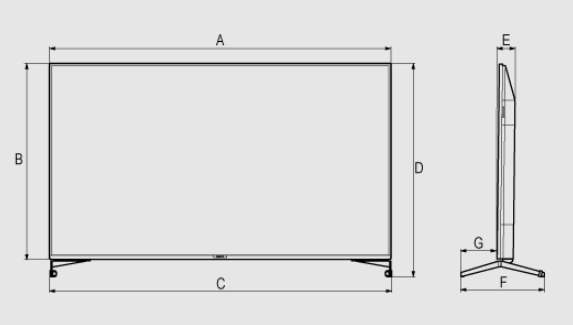If you’re planning to buy a 75-inch television, you need to know its dimensions. A 75-inch television will typically measure between 63-64 inches wide and 41-43 inches tall, with the stand. Whether it stands alone or on a stand, the 75-inch TV body will be twelve to fifteen inches deep. The height, width, and depth of a 75-inch TV may differ, but they are typically close to the same.
9.5 feet
The 75 inch television is a very large screen. Its height, width, and depth are larger than the actual television, so it is crucial that you measure your room before purchasing a new TV. This measurement will help you choose the best position for your television. Generally, you should place your 75-inch television between six and 9.5 feet away from your viewing area. To make your television more comfortable to watch, you should consider the distance between the screen and the closest wall or floor.
The weight of a 75 inch TV is a major concern for many buyers. While plasma models are lighter, plastic models are also heavier than equivalent plasma models. Adding the glass panel to the design makes it a fragile object, and the weight can be particularly deterring to some people. It is especially difficult to hang a 75-inch TV on drywall, and some people have trouble mounting it in that location.
The viewing distance for a 75-inch television depends on several factors, such as the viewing environment and the angle of the screen. In general, you should sit at least three times the height of the television. For example, a 75-inch television is 38.5 inches high, and you should sit at least 115.5 inches away from it. That is about 9.6 feet, or about 3.5 meters. However, the actual distance varies, so don’t be afraid to get a larger television if you’re concerned about the size of your space.
If your space is limited, consider how you plan to mount the TV. If it isn’t going to occupy too much space, consider mounting it over a fireplace or mantle. However, make sure that the room is wide enough to fit the TV. Once it is positioned over the mantle or fireplace, the 75” television should be able to be viewed by the most people.
Also Read: Buying an 82 Inch TV? Here’s What You Need to Know
3 to 4 inches thick
If you’re putting together a custom cabinet to house your 75-inch television, you will want to keep in mind that it will be three to four inches thick. While this might sound small, the thickness of your television will be more important than you think, because it will affect the appearance of your cabinet. While three to four inches is usually standard for 75-inch televisions, this thickness can vary depending on the brand.
Choosing the right size stand for your television can be a challenge, but with the help of some guidelines, you can make the right choice. The most common rule of thumb is to go with a stand that is three to four inches thick, as this will help keep your television in an even position and give your room a more uniform look. However, if you’re going with a stand, a little more overhang isn’t necessarily a bad thing, as you can use the extra space for picture frames or decorations.
Another important factor when choosing a stand for a 75-inch TV is to take measurements of the television. Most of these TVs will be between 65 and 67 inches wide. The thinnest frames are usually on the lower end of this scale. The TCL 4-Series 75-inch television, for example, measures only 66.1 inches wide. Generally, you should choose furniture that is wider than your TV, so that it can be supported easily.
Although you don’t need a big stand for a 75-inch TV, you will need to consider rearranging the room if you plan to use it in your living room. Although 75-inch TVs are relatively large, you won’t need a lot of room for peripherals. In fact, you can get away with using only a small space to place your 75-inch TV.
Also Read: Finalmouse Starlight 12 Review
68 inches wide
A 68 inches wide 75-inch television is 66 inches long and three-quarters-inch wide. This diagonal measurement makes the screen appear wider if you stand at the right distance. For Ultra HD and 4K resolutions, it is best to place the television between 6.3 feet and nine feet from the viewer. For optimal viewing angles, the optimum distance to the screen is about nine feet, while the minimum distance is two feet.
Another important factor when measuring a TV is its diagonal. The diagonal measures the distance between the upper corner and the lower corner of the opposite-size side. As such, it is crucial to measure your television diagonal. Using the Pythagorean Theorem, the diagonal of a 75-inch TV is equal to 2x its width. Moreover, a television with a diagonal less than 3 inches will be thicker than a 68-inch TV.
For small rooms, a 75-inch television may not be practical. This screen size requires a large stand that can take up a large portion of floor space. In this case, it is better to choose wall-mounted televisions since they will save space and eliminate the need for extra furniture. However, it is important to note that a 75-inch television will require a room that measures at least 115.5 inches wide. If you have a larger room, you may be able to accommodate a 75-inch television.
Before purchasing your 70-inch television, find a suitable place to mount it. Measure the screen size with a stud finder. If you notice any studs, a stud finder should light up or beep. Use the measurement as a guide when planning a mounting location. If your television is larger than its stand, you will have to adjust its height to accommodate it.
15 inches deep
Television dimensions are often given in inches, and are based on the distance between the two most distant corners of the screen. When measuring the screen dimensions, make sure to take the bezel and frame into account as well. This will help you determine the space needed for your television. Using the dimensions below, you can choose a suitable television stand. In general, 75 inches is considered a large screen, and 15 inches is a standard depth.
The size of your room will determine how you place your new 75-inch TV. If you’ve got a big room, you might want to consider mounting the television on a wall and placing it on a TV stand. This will save you a lot of floor space and eliminate the need for additional furniture. However, a wall mount may increase your viewing distance by one foot. It may also create a slight viewing angle.
The depth of a 75-inch TV is a difficult measurement to make because it’s impossible to predict exactly how much the screen will be when fully extended. The height of the screen, which includes the bezel, is measured from the top corner to the bottom. Make sure to measure the depth of the TV stand as well as the TV’s height. Lastly, a 75-inch television should be at least 24 inches off the floor, but it’s important to take into account the depth of the stand.
The width and depth of a 75-inch television can vary widely depending on the type of stand. Some are shallower than others, requiring a 68-inch stand to balance them. Other designs may be more flexible, allowing you to balance the size of the TV with other objects in the room. If you’re looking for a stand that fits your 75-inch TV, look for one with a base that is 15 inches deep.
LCD vs OLED
A key difference between LCD and OLED TVs is response time, which refers to the time it takes for individual pixels to change state, such as color or brightness. The faster response time, the better, as it means less blur and artifacts. An OLED TV is the most advanced technology available today, but its lifespan is still only about two decades. On the other hand, LCD TVs use tiny LCD “shutters” to create color. The latter is slower to react to changes in state than OLED, and the former is only expected to last for two decades.
When it comes to buying a large flat-panel TV, an LCD or OLED model is the easiest to purchase. Both types of TVs are available at various retail stores and from manufacturers directly. For example, the 77-inch OLED is available at Best Buy and Amazon. Choosing a TV depends on your budget and preferences. You can choose an LCD or OLED model based on these specifications.
In addition to their differences in size, LCD TVs offer superior black levels and wide viewing angles. OLED TVs have a more expensive price, but they have a proven track record and are less likely to suffer from backlight flickering. LCD televisions also offer a solid webOS smart platform and are cheaper than OLED models. They may not look the same, but they do deliver superior colors and black levels.
Although 75-inch TVs are becoming increasingly popular, you must keep in mind that the actual dimensions of their screens differ. If you are purchasing a 75-inch TV, you should mount it at least 24 inches off the floor. As with other sizes, the dimensions are often expressed as diagonal length. You should not forget to consider the bezel, which can vary between brands. However, the difference in size between a television’s screen is usually half an inch or more.


